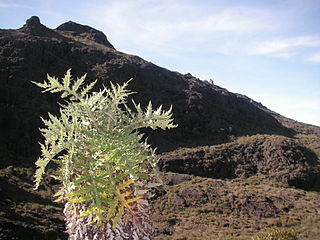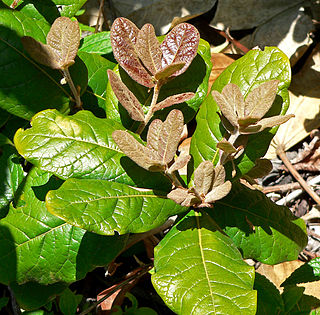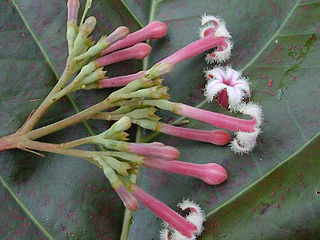
Dieffenbachia, commonly known as dumb caneorleopard lily, is a genus of tropical flowering plants in the family Araceae. It is native to the New World Tropics from Mexico and the West Indies south to Argentina. Some species are widely cultivated as ornamental plants, especially as houseplants, and have become naturalized on a few tropical islands.

Heliconia is a genus of flowering plants in the monotypic family Heliconiaceae. Most of the ca 194 known species are native to the tropical Americas, but a few are indigenous to certain islands of the western Pacific and Maluku in Indonesia. Many species of Heliconia are found in the tropical forests of these regions. Most species are listed as either vulnerable or data deficient by the IUCN Red List of threatened species. Several species are widely cultivated as ornamentals, and a few are naturalized in Florida, Gambia, and Thailand.
La Selva Biological Station is a protected area encompassing 1,536 ha of low-land tropical rain forest in northeastern Costa Rica. It is owned and operated by the Organization for Tropical Studies, a consortium of universities and research institutions from the United States, Costa Rica, and Puerto Rico. Recognized internationally as one of the most productive field stations in the world for tropical forest research and peer-reviewed publications, La Selva hosts approximately 300 scientists and 100 university courses every year. The primary goal of La Selva Biological Station is to preserve and protect an intact forest, as well as providing laboratory facilities for tropical research and education. The research potential of the area is not only vital to tropical ecology, but it is also an important location in the effort to study relations between local communities and protected areas. In addition, its high diversity and ease of access to the Puerto Viejo-Horquetas highway makes La Selva an important ecotourism destination and environmental education center for tourists and the local community.
The New Mexico State University Agricultural Experiment Station is a system of scientists who work on facilities on the main campus in Las Cruces and at 12 agricultural science and research centers located throughout the state of New Mexico. It facilitates and administers the botanical gardens, the NMCR herbarium, and other agricultural facilities associated with New Mexico State University.

Tapantí - Cerro de la Muerte Massif National Park,, is a National Park in the Central Conservation Area of Costa Rica located on the edge of the Talamanca Range, near Cartago. It protects forests to the north of Chirripó National Park, and also contains part of the Orosí River. The area known as Cerro de la Muerte Massif was added to the park on January 14, 2000.

Chirripó National Park is a national park of Costa Rica, encompassing parts of three provinces: San José, Limón and Cartago. It was established in 1975.

Calyptrogyne is a genus in the palm family (Arecaceae). The distribution of this genus is Central America, Colombia, and southern Mexico, with 11 of the 17 known species endemic to Panama. Calyptrogyne ghiesbreghtiana is the most widespread and best studied species in this genus.

Quercus costaricensis is a species of oak native to Central America. It is often found with Quercus copeyensis in the upper montane forests, to 3,100 metres elevation. The leaves are tough and leathery with a short petiole and toothed margin. Wind is the primary pollinator. Squirrels are their main seed predator but also their main disperser as they commonly lose their buried seeds.
The Organization for Tropical Studies (OTS), founded in 1963, is a non-profit consortium of over 50 universities and research institutions based in the United States, Latin America, and South Africa. OTS manages a network of ecological research stations in Costa Rica and South Africa. The North American Office is located on the Duke University campus in Durham, North Carolina. OTS offers a variety of courses in Spanish and English for high school, university, and graduate students. Most of the coursework and research conducted at OTS stations focuses on tropical ecology, and the three research stations in Costa Rica are located in distinct ecoregions.
The Palo Verde Biological Research Station is located in the Guanacaste Province of Costa Rica, and is one of the three research stations operated by the Organization for Tropical Studies (OTS). The Biological Research Station is located inside Palo Verde National Park. Palo Verde Biological Research Station is one of the foremost sites for ecological research on tropical dry forests, which constitute one of the most endangered forest types in the world.

Cinchona pubescens, also known as red cinchona and quina (Kina), is native to Central and South America. It is known as a medicinal plant for its bark's high quinine content- and has similar uses to Cinchona officinalis in the production of quinine, most famously used for treatment of malaria.

The Lankester Botanical Gardens are a set of gardens outside of Cartago, Costa Rica. The garden is open to the public, but is operated by the University of Costa Rica (UCR) as a research center and is a major center for orchid research in both Central America and the Caribbean.
Dermophis gracilior is a species of caecilian in the family Dermophiidae. It is found on the Pacific slopes of Cordillera de Talamanca in eastern Costa Rica and western Panama, as well as in the central Pacific Costa Rica. Some sources also report it from the Atlantic slope of Costa Rica.

Ibo Bonilla Oconitrillo is an architect, sculptor, mathematician and educator of Costa Rica. He has Costa Rican and Spanish nationality. He is known mainly because of the creation of Bioclimatic Buildings and his Monuments in Public Square.
UGA Costa Rica is one of the three international residential centers owned and operated by the University of Georgia. The largest of these centers—the other two located in Oxford, England and Cortona, Italy—UGA Costa Rica is used as a site for research, study abroad, symposia, and ecotourism.
Roy Edward Halling is an American mycologist.
San Vito, originally named San Vito de Java, is a district and head city of the Coto Brus canton, in the Puntarenas province of Costa Rica. It is located about 271 kilometres (168 mi) southeast of the capital San José, and close to the Panama border.
John Jeffrey Ewel is an emeritus professor and tropical succession researcher in the department of biology at the University of Florida. Most of his research was conducted through experimental trials to understand ecosystem processes in terrestrial and tropical environments. The results of the research provided the ability to further comprehend forest structure and management, as well as its nutrient dynamics. The primary research conducted dealt with the beginning stages of the regrowth and recovery following agriculture practices. Ewel also participated in studies regarding invasive species and restoration ecology.

Michael Jeffrey Balick is an American ethnobotanist, economic botanist, and pharmacognosist, known as a leading expert on medicinal and toxic plants, biocultural conservation and the plant family Arecaceae (palms).
Clypeopyrenis porinoides is a species of corticolous (bark-loving) lichen in the family Pyrenulaceae. Found in Costa Rica, it was described as new to science in 2011 by Harald Komposch, Jesús Ernesto Hernández Maldonado, and Dania Rosabal. The type specimen was found near the Las Cruces Biological Station in Sán Vito de Coto Brus at an altitude of 1,200 m (3,900 ft). Here the lichen was growing on trunks and undergrowth in a primary forest. The specific epithet porinoides refers to its resemblance to species of Porina.









